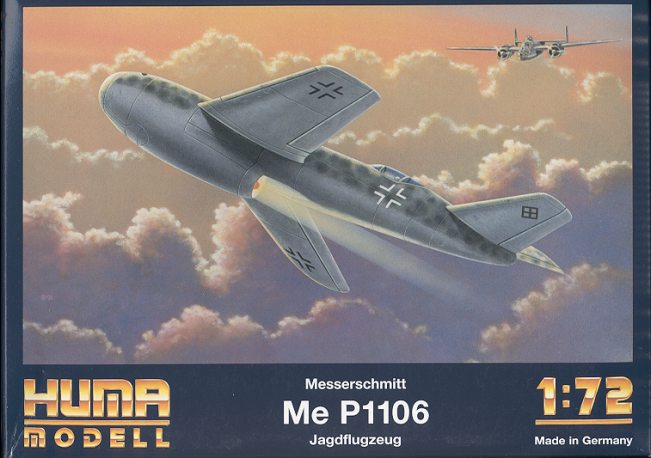
Huma 1/72 Messerschmitt P.1106
|
KIT # |
3006 |
|
PRICE: |
$14.98 |
|
DECALS: |
Generic |
|
REVIEW : |
|
|
NOTES: |

|
THE STORY |
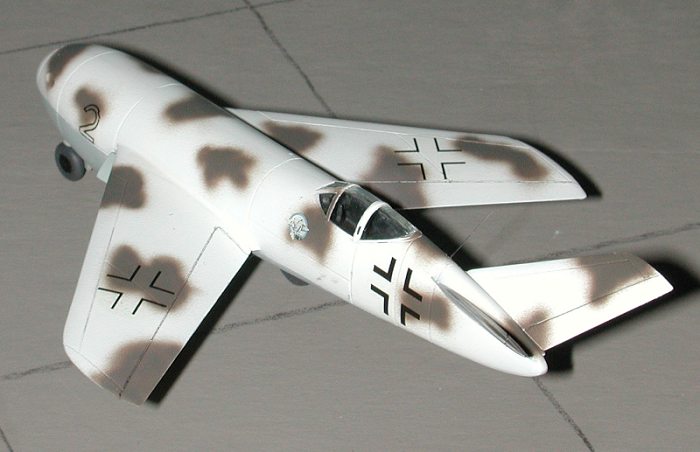
A horrible klaxon sound awakes Unteroffizier (sergeant) Peter Maxx from a sound sleep. "Damn, just when the dream was getting good". A wave of chilled air greets him as he tosses off the thick blankets and scurries to get into his flying clothes. Finally dressed, he and the other enlisted pilots scramble out the door of their communal living quarters and are welcomed by a vista of snow, mountains, and even more frigid air. The truck waiting to take them to their aircraft slides to a stop in front of a row of unpainted wooden barracks. Trudging through the snow, they hop into the unheated back of the Opel truck and with a grinding of gears and spinning of rear tires, the truck makes its way to the revetments where their aircraft await them.
As the truck careens and slithers on the snowy road down to the shores of the fjord where the runway and revetments are located, Peter reminds himself that he should never again volunteer for anything. Lured by the promises of glory and the excitement of being assigned to a very secret installation, he and several of his comrades eagerly signed up for what was supposed to be a glorious tour. They were told that their skills were needed to provide defense for a secret base at a location that they could not be told about until they arrived. As they boarded a white painted Ju-290 transport aircraft, the first thing they saw was a pile of cold weather gear. Spirits faltered at what that might foretell. Taking off from their base in southern France, the aircraft flew north, making stops in Ireland and Iceland. It then headed southwest along the coast of Greenland before rounding the southern tip and flying northwest until it reached one of a number of similar looking fjords. Turning up a rather large one, it came to the end, and there, nestled at the base of it was their new home at Iterlak. He was soon to become part of Sonderkommando Greenland!
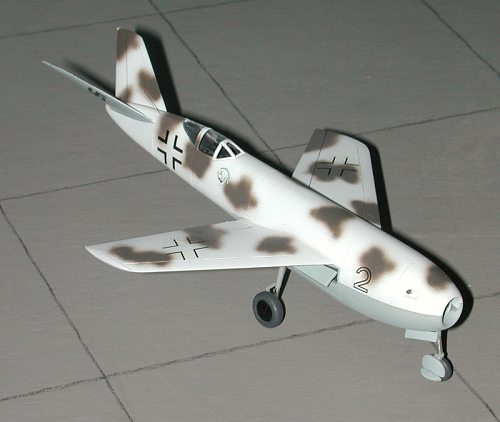 Basically, it was a
runway and revetments at the foot of the fjord, with the rest of the base
winding its way up the side. All of the buildings, the runway and aircraft were
camouflaged to try to blend in with the surroundings. Take off was down the fjord, which wasn't too bad.
It was landings that were critical as there was no going around. If you touched
down and had problems, you only had a single barricade to hit before the fjord walls
stopped you. Because of the
'one way' design of the runway, both take-offs and landings could not be done
simultaneously. If you had aircraft problems, you could be in very serious
trouble. No wonder they wanted volunteers. No wonder we were told it was
hazardous. No wonder I wanted to be back in France!
Basically, it was a
runway and revetments at the foot of the fjord, with the rest of the base
winding its way up the side. All of the buildings, the runway and aircraft were
camouflaged to try to blend in with the surroundings. Take off was down the fjord, which wasn't too bad.
It was landings that were critical as there was no going around. If you touched
down and had problems, you only had a single barricade to hit before the fjord walls
stopped you. Because of the
'one way' design of the runway, both take-offs and landings could not be done
simultaneously. If you had aircraft problems, you could be in very serious
trouble. No wonder they wanted volunteers. No wonder we were told it was
hazardous. No wonder I wanted to be back in France!
Reaching the revetments, which had been partially carved out of the fjord walls, they found that their faithful mechanics had already started the engines of their 'tadpoles'. The Messerschmitt 1106s were quite similar to the 1101s that they had been flying back in France. The only difference was that these had the cockpit moved much farther aft and it had a V tail. It took a bit of getting used to at first, having all that aircraft out in front of you, but once used to it, it wasn't bad at all. These aircraft were designed as interceptors anyway and were not really stressed for dogfighting. As he clambered into the cockpit, he thanked the designers for installing a good heating system in them. He also wondered who came up with this camouflage design. It reminds him of cows!
Taxiing his Greenland camouflaged # 2 aircraft onto the taxiway, he got on the radio to find out what the situation was. Apparently, the radar network had picked up a force of aircraft heading toward the large German base at Reykjavik in Iceland. These aircraft were flying at about 10,000 meters on an easterly bearing. According to the radar, they were not large enough to be bombers and were moving swiftly.
Climbing up to 11,000 meters, the group received additional bearing information and were told to conserve fuel as best as they could. Cruising at nearly 600kph, they scanned below them for any sight of an enemy force. Nothing. The controllers must be tracking a flock of birds!
Suddenly, off to the left there is a glint that looks more metallic than a reflection from the ocean below. Peering intently, Peter sees more glints. Those must be the enemy! Radioing his sightings to the leader, they fly an intercept course, still staying above the suspect craft.
As they fly nearer, they see that there is a group of about 20 natural metal, straight winged aircraft. Straining to identify them, Peter realized that these are American P-83s, a long range fighter bomber that he had heard about. Twin engined and with the ability to carry a decent payload a very long way. There is no way they could have the range to fly from the US to Iceland and back. There must be a base somewhere in northern Canada.
Time for pondering is over. The Staffel Kapitan orders the group to attack and the small interceptors head down toward the still unsuspecting enemy formation. As they near, it is plain that they have been spotted. He sees objects falling from a few of the aircraft to the rear as they angle up to meet the attackers. Soon there is a melee of small German aircraft and a few larger US types. Some of the German flyers head for the larger force while Peter and his comrades take on the defenders. There is much tracer fire angling through the skies as the bigger American planes twist and turn in an attempt to knock down the interceptors. Their larger, broader wings give the Americans an advantage in a dogfight that the swept wing German planes cannot match.
 With most of the
German attackers involved with the
defending fighters, the majority of the US force speeds away; gaining speed as
they lose altitude. The German fighters cannot maintain the chase and still have
enough fuel to get home, so those following reluctantly give up and head back
home. Though riddled with .50 cal machine gun bullets, Peter's 1106 is still
trying to knock down one of the defending fighters. Suddenly, the defenders try
to break off combat and head back to the west. Peter sees his chance and
starts to chase one of them. Despite calls from his friends to head back to
base, he follows one plane and manages a number of hits with his 30mm cannon in
the left wing root. This starts the wing on fire and he watches as the wing
falls off and the plane starts spinning into the ocean below. A parachute pops
out and the pilot drifts to the frigid waters below.
With most of the
German attackers involved with the
defending fighters, the majority of the US force speeds away; gaining speed as
they lose altitude. The German fighters cannot maintain the chase and still have
enough fuel to get home, so those following reluctantly give up and head back
home. Though riddled with .50 cal machine gun bullets, Peter's 1106 is still
trying to knock down one of the defending fighters. Suddenly, the defenders try
to break off combat and head back to the west. Peter sees his chance and
starts to chase one of them. Despite calls from his friends to head back to
base, he follows one plane and manages a number of hits with his 30mm cannon in
the left wing root. This starts the wing on fire and he watches as the wing
falls off and the plane starts spinning into the ocean below. A parachute pops
out and the pilot drifts to the frigid waters below.
Peter breaks off and starts a fuel conserving flight back to base. He calls ahead in hopes that a rescue plane can be sent out for the P-83 pilot, but knows that the man's chances of survival are slim. As he nears the base, his fuel status is critical. He makes it to the entrance of the fjord and starts his approach. Sweating profusely, he guides his aircraft to the landing strip.
He is so close to landing that he can taste it. He lowers his flaps to slow his approach. Then the gear come down. Home is in sight! Just then the engine sputters and quits. Low and now with too little airspeed, his Messerschmitt quickly seeks the ground below. It finds it with an resounding crash. Sliding along the gravel of the beach just before the threshold, the little jet sheds its landing gear, then, when a wing digs into the beach, the aircraft spins around and comes to a quick stop up against a boulder.
Peter is thrown against the gunsight with a force that brings much pain and he blacks out. He awakens in the back of the truck hurrying him to the hospital. His jaw aches, but he seems rather detached to what is happening around him. 'Oh well,' he thinks 'At least it was an even trade. One for one.' He then blacks out again, not looking forward to the butt chewing the kommandeur will give him for losing the aircraft.
|
HISTORY & THE KIT |
For background on the aircraft and a look at what's in the box, go to this preview.
|
CONSTRUCTION |
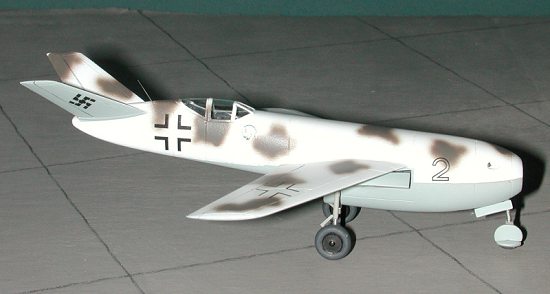 With only 33 pieces, this kit isn't exactly going to be a long
term build. This kit includes a complete, though not very detailed jet engine.
The reason for it is that you can see it through the wheel wells. So that was
the first thing I assembled. There are compressor and exhaust turbine blades to
install. The front one was painted aluminum and the aft burnt iron. The inlet
and exhaust ducts were also painted that color. Then I packed weight into the
space in between. This will be a tail-sitter with out adding weight and with the
engine quite visible, finding spots to put the weight will be a challenge.
With only 33 pieces, this kit isn't exactly going to be a long
term build. This kit includes a complete, though not very detailed jet engine.
The reason for it is that you can see it through the wheel wells. So that was
the first thing I assembled. There are compressor and exhaust turbine blades to
install. The front one was painted aluminum and the aft burnt iron. The inlet
and exhaust ducts were also painted that color. Then I packed weight into the
space in between. This will be a tail-sitter with out adding weight and with the
engine quite visible, finding spots to put the weight will be a challenge.
During this time, the interior, such as it is, was constructed. There is basically a floor, fore and aft bulkhead, seat, stick and instrument panel. These items as well as the fuselage insides where the cockpit goes, were all painted RLM 66 Black Grey. The engine bay part of the forward fuselage was painted RLM 02 Grey. There is a small decals that fits on the instrument panel and it was put on when the paint had dried. A drop of Solvaset ensured it would stay there.
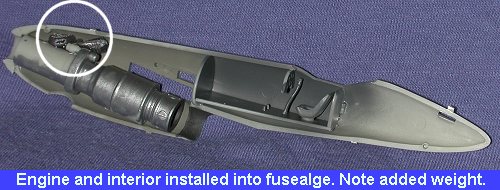 Then the engine
and interior were glued into the right fuselage half. You have to use the right
side as there are no attachment points on the left side! I managed to squeeze a
few more bits of lead into the very front of the fuselage above the engine where
it won't be easily seen. Then the fuselage halves were glued together and the
seam sanded smooth.
Then the engine
and interior were glued into the right fuselage half. You have to use the right
side as there are no attachment points on the left side! I managed to squeeze a
few more bits of lead into the very front of the fuselage above the engine where
it won't be easily seen. Then the fuselage halves were glued together and the
seam sanded smooth.
Meanwhile, the wings and tailplanes were cut from the sprues and
the mold seam along the edges cleaned up. The wings were then attached to the
fuselage. As
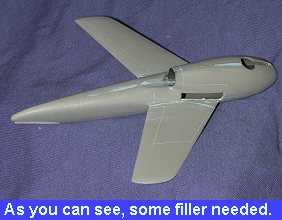 can be
imagined,
I needed to use filler on the seams to fill up the gaps that were there, but
this is standard procedure for me in particular and for short run kits in
general. I then noticed that there was a rather noticeable gap between the
engine front and the fuselage. In fact, the engine appears to be a bit smaller
in diameter compared to the
can be
imagined,
I needed to use filler on the seams to fill up the gaps that were there, but
this is standard procedure for me in particular and for short run kits in
general. I then noticed that there was a rather noticeable gap between the
engine front and the fuselage. In fact, the engine appears to be a bit smaller
in diameter compared to the 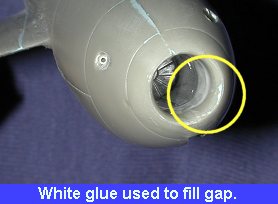 opening.
While I was able to carve the engine inlet enough to match the intake, I needed
to use white glue to fill in the spaces. It took a couple of applications, but
at least there isn't a huge gap there any longer. The small blanking plate
behind the cockpit was then installed. It is a bit shorter than what is needed
(or I installed the cockpit too far forward). Some gap filling superglue
followed by sanding took care of that problem.
opening.
While I was able to carve the engine inlet enough to match the intake, I needed
to use white glue to fill in the spaces. It took a couple of applications, but
at least there isn't a huge gap there any longer. The small blanking plate
behind the cockpit was then installed. It is a bit shorter than what is needed
(or I installed the cockpit too far forward). Some gap filling superglue
followed by sanding took care of that problem.
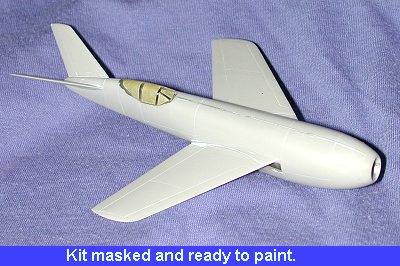 Once the plate was installed and smoothed, the tailplanes were
glued in place. I had to trim the mounting tabs a bit in order to get both of
them to fit in all the way. There was also need to open up the left slot a bit
as it was too narrow. Once glued in place, and dry, filler was used at the seams
and smoothed out. Moving on to the canopy, it was test fit and it was noted that
it didn't want to fit at the very back. Taking a sanding stick, the fuselage in
that area was sanded down until the canopy fit flush. Then it was glued in place
and when dry, masked. It was now time to stuff tissue in the openings and head
for the paint shop for the initial application of paint.
Once the plate was installed and smoothed, the tailplanes were
glued in place. I had to trim the mounting tabs a bit in order to get both of
them to fit in all the way. There was also need to open up the left slot a bit
as it was too narrow. Once glued in place, and dry, filler was used at the seams
and smoothed out. Moving on to the canopy, it was test fit and it was noted that
it didn't want to fit at the very back. Taking a sanding stick, the fuselage in
that area was sanded down until the canopy fit flush. Then it was glued in place
and when dry, masked. It was now time to stuff tissue in the openings and head
for the paint shop for the initial application of paint.
|
PAINT |
The underside of the aircraft was painted RLM 76 blue, using enamels from the now defunct Aeromaster line. When dry, the underside colors were masked off and the uppersurface was painted white. For me, much of the fun of building these kits is to make up an unusual camo scheme. Of course, to do that, I have to have a story written to match. I tried building the kit and then writing the story, but it works a lot better the other way around. Once the white had dried, it was time to apply the 'Greenland' camouflage scheme. Basically, it consists of large, irregular patches of RLM 81 brown. This is to get the aircraft to blend in with the patchy snow covered areas near the fjord where the planes are based. It was fun to apply!
When that was done and dry, the aircraft was next given a coat of gloss acrylic to provide a smooth base for the decals. Apart from a unit badge and aircraft number, there would be no other distinguishing markings.
|
CONSTRUCTION CONTINUES |
Once the kit was painted, I decided to go ahead and finish building it before applying the decals. Since this is a very simple kit, the only parts left were the installation of the landing gear and gear doors. There are no real wheel wells for this. The nose gear plugs into a hole in the underside of the engine, while the main gears have a slot they plug into in the back of the main gear openings.
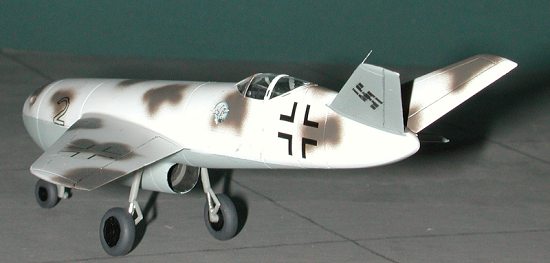 The gear were painted RLM 02 grey and the wheels black. Bare
Metal Foil was used to simulate the oleos on the struts. The scissors are
nothing more than two 'L' shaped pieces of plastic. These were glued in place.
There is none for the nose gear. Once the gear was in and dry, the wheels were
glued on. Fit is ok on the main gear, but a bit sloppy for the nose gear.
The gear were painted RLM 02 grey and the wheels black. Bare
Metal Foil was used to simulate the oleos on the struts. The scissors are
nothing more than two 'L' shaped pieces of plastic. These were glued in place.
There is none for the nose gear. Once the gear was in and dry, the wheels were
glued on. Fit is ok on the main gear, but a bit sloppy for the nose gear.
After the gear and wheels are dry, the gear doors are to be glued in place. These are all butt joined and the main doors only have a small area to glue. I also deviated from the instructions and glued the small nose gear door to the fuselage instead of the nose gear.
|
DECALS |
Decals came from a variety of sources. The fuselage insignia was from the kit decals, the wing insignia from a Microscale sheet, the swastika from an Xtradecal sheet, the unit badge from an ESCI Belgian AF sheet and the number from an ESCI 1/48 Mirage IIIE sheet. I used Solvaset to make sure the decals snuggled down and stuck.
Final step was to spray a semi-matte clear on the kit to seal things in. Then the tape was taken off and a small whip antenna installed aft of the canopy.
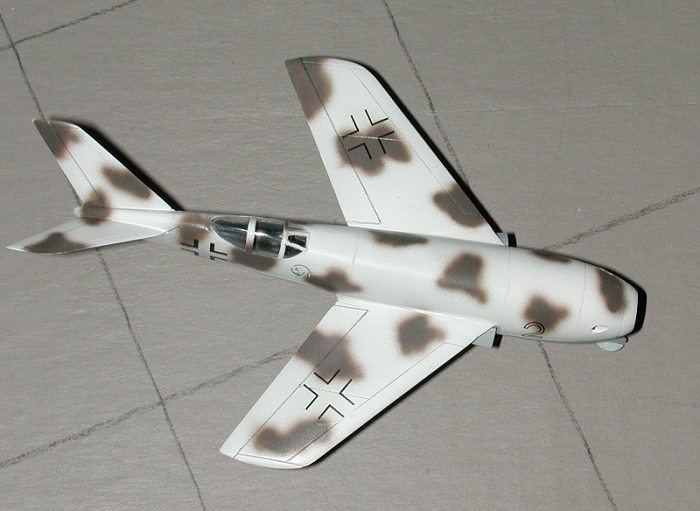
|
CONCLUSIONS |
This kit was a real breeze to build. Thanks to the limited number of parts, it was a bit over a week from start to finish. I like these Luft '46 kits as I can use my imagination on what they may have looked like when in unit service. I can recommend this kit to all skill levels. If you haven't tried one, and have an interest, I heartily recommend picking one up.
Copyright ModelingMadness.com. All rights reserved. No reproduction in part or in whole without express permission from the editor.
Review kit courtesy of me and my wallet!
If you would like your product reviewed fairly and fairly quickly, please contact the editor or see other details in the Note to Contributors.
Back to Reviews Page 2016